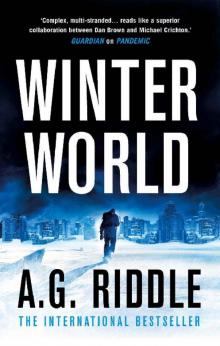- Home
- A. G. Riddle
The Atlantis Gene: A Thriller Page 2
The Atlantis Gene: A Thriller Read online
Page 2
David kept his eyes focused on the newsstand. His ear piece crackled to life. “Collector, Watch Shop. Be advised, we’re zero-hour plus twenty.”
The contact was late. The team was growing nervous. The unspoken question was: do we abort?
David raised his mobile phone to his face. “Copy, Watch Shop. Trader, Broker, report.”
From his vantage-point, David could see the two other operatives. One sat on a bench in the middle of the bustling crowd. The other man was working on a light near the restrooms. Both reported no sign of their anonymous informant, a man who claimed to have details of an imminent terrorist attack called The Toba Protocol.
The operatives were good, two of Jakarta station’s best; David could barely pick them out of the crowd. But as he surveyed the crowd, something unnerved him slightly, like the tingling when the hair on your arm stands on end. Or more like the sensation you get when you realize a bug is crawling on you, those few seconds before you see it, jump up, and either run or start swatting furiously.
The ear piece crackled again. It was Howard Keegan, the Director of Clocktower, the counter-terrorism organization David worked for. “Collector, Appraiser, it seems the seller didn’t like the market today.”
David was Jakarta Station Chief, and Keegan was his boss and mentor. The older man clearly didn’t want to step on David’s toes by shutting down the operation, but the message was clear. Keegan had come all the way from London, hoping for a break. It was a big risk given the other ongoing Clocktower operation.
“Agree,” David said. “Let’s shut it down.”
The two operatives casually vacated their positions and melted into the throngs of scurrying Indonesians.
David took one last look at the newsstand. A tall man with a red windbreaker was paying for something. A newspaper. The New York Times.
“Standby, Trader and Broker. We have a buyer looking at merchandise,” David said.
The man stepped back, opened the paper, and paused for a few seconds to read the front page. Without looking around, he closed the newspaper, tossed it in the trash can, and walked quickly toward the loaded train moving away from the station.
“Contact. I’m engaging.” David’s mind raced as he bounded from the shadow and into the crowd. Why was the man late? And his appearance — it was… wrong. The overt red windbreaker, the posture (a soldier’s posture, or an operative), the way he walked.
The man pushed onto the train and began snaking through the thick crowd of standing men and sitting women. The man was taller than almost everyone on the train, and David could still see his head. David squeezed onto the train and stopped. Why was the contact running? Had he seen something? Been spooked? And then it happened. The man turned, glancing back at David, and the look in his eyes said it all.
David wheeled around and swept the four men standing in the doorway out onto the platform. He pushed them away from the train as more anxious commuters poured onto the train in the hole he had made. David was about to shout when the explosion tore through the train, spraying shards of glass and metal into the station. The blast threw David to the concrete floor of the platform, sandwiching him between bodies, some dead, some writhing in pain. Screams filled the air. Through the smoke, pieces of ash and debris drifted down like falling snow. David couldn’t move his arms or legs. His head rolled back, and he almost lost consciousness.
For a moment he was back in New York, running away from the crumbling building, then he was under it, trapped, waiting. And arms were on him, pulling him out. “We got you buddy,” they said. The sirens from FDNY and NYPD rang out as the sunlight hit his face.
But it wasn’t an ambulance this time. It was a black delivery van outside the train station. The men, not FDNY. The two operatives, Trader and Broker. They hoisted David into the van and sped away as Jakartan police and fire teams filled the streets.
CHAPTER 3
Autism Research Center (ARC)
Jakarta, Indonesia
Playroom four was buzzing with activity. The scene was typical: toys strewn everywhere with about a dozen children scattered throughout the room, each playing alone, focused intensely. In the corner, an eight-year-old child named Adi rocked back and forth as he built a puzzle with ease. When he placed the last block, he looked up at Ben, a proud smile on his face.
Kate couldn’t believe it.
The boy was assembling a puzzle her team used to identify savants — autistic individuals with special cognitive abilities similar to the movie character Rain Man. The puzzle required an IQ in the 140-180 range. Kate couldn’t do it, and only one child in the study could — Satya.
Kate watched as the child quickly built the puzzle, tore it down, and built it again. Then Adi stood up and took a seat on a bench beside Surya, a seven-year-old in the study. The smaller boy got up and completed the puzzle with just as much ease.
Ben turned to Kate. “Can you believe it? You think they’re doing it from memory? From watching Satya?”
“No. Or maybe. I doubt it,” Kate said. Her mind raced. She needed time to think. She had to be sure.
“This is what you’ve been working on, isn’t it?” Ben said.
“Yes,” Kate said absently. It was impossible. It shouldn’t have worked so quickly. Yesterday, these children were classic cases of autism — if there was such a thing. Increasingly, researchers and physicians had begun recognizing autism as a spectrum of disorders with a wide range of symptoms. At the core of autism was a dysfunction in communication and social interaction. Most affected children avoided eye contact and socializing, others wouldn’t respond to their names, and in severe cases, children couldn’t stand any contact. Yesterday neither Adi or Surya could have completed the puzzle, made eye contact, or much less taken turns.
She had to tell Martin.
“What do you want to do?” Ben said. The excitement was clear in his voice.
“Take them to observation two. I need to make a call.” The disbelief, exhaustion, and joy fought a battle in Kate’s mind. “And, uh, we should administer a diagnostic. ADI-R. No, ADOS 2, it will take less time. And let’s film it.” Kate smiled and gripped Ben’s shoulder. She wanted to say something profound, something that would mark the moment, words like she imagined brilliant and now famous scientists say at the breakthrough moment, but no words came, just a weary smile. Ben nodded and then took the children by the hands. Kate opened the door, and the four of them walked out into the corridor where two people were waiting. Not people. Monsters, dressed head-to-toe in black military gear: a helmet that covered a cloth mask, dark ski-like goggles, body armor, and black rubber gloves.
Kate and Ben stopped, glanced at each other in disbelief, and corralled the children behind them. Kate cleared her throat and said, “This is a research lab, we don’t have any cash here, but take the equipment, take whatever you want. We won’t—”
“Shut up.” The man’s voice was rough, like someone who had spent a lifetime smoking and drinking. He turned to his smaller black-clad accomplice, who was clearly a woman, and said, “Take them.”
The woman took a step forward, making for the children. Without thinking, Kate moved into her path. “Don’t, take anything, take me inst—”
The man took out a handgun and pointed it at her. “Don’t, Dr. Warner. I don’t want to hurt you, but I will.”
He knew her name.
Out of the corner of her eye, Kate saw Ben move closer, making for the gap between her and the monster with the gun.
Adi tried to run, but the woman grabbed him by his shirt.
Ben was beside her, then in front of her and they were both rushing for the man with the gun. They tackled him. The gun went off. The children screamed.
Kate saw Ben tumble to the ground. Blood was everywhere.
The man had her. He was too strong. He pinned her to the ground, and she heard a loud crack—
CHAPTER 4
Immari Corp. Research Complex
Outside Burang, China
&nbs
p; Tibet Autonomous Region
The project director walked into Dr. Shen Chang’s office and threw a file onto his desk. “We have a new therapy.”
Dr. Chang grabbed the file and began riffling through the pages.
The director paced the length of the room. “It’s very promising. We’re fast-tracking it. I want the machine ready and subjects treated with the new therapy within four hours.”
Chang dropped the file and looked up.
The scientist opened his mouth, but the director waved him off. “I don’t want to hear it. The singularity could happen at any time — today, tomorrow, it could have already happened for all we know. We don’t have time for caution.”
Chang began to speak, but the director cut him off again. “And don’t tell me you need more time. You’ve had time. We need results. Now tell me what it’s going to take.”
Chang slumped in his chair. “The last test was a strain on the local power grid, we exceeded our capacity onsite. We think we fixed the problem, but the regional power authority has to be suspicious about what we’re doing. The bigger issue is that we’re low on primates—”
“We’re not testing it on primates. I want a human cohort of 50 ready to test.”
Chang straightened himself and said with more force, “Setting the morality aside, which I urge you not to do, we would simply need a lot more data to begin a human trial, we would need—”
“You have it doctor. It’s all in the file. And we’re retrieving more data now. That’s not all. We have two subjects with sustained Atlantis Gene activation.”
Chang’s eyes widened, “You, two, how—”
The man pointed to the file in a cobra-like, short motion. “The file doctor. It’s all there. And they’ll be here, soon. You better be ready. All you have to do is replicate the gene therapy.”
Chang was flipping through the pages, reading, and murmuring to himself. He looked up. “The subjects are infants?”
“Yes. Is that a problem?”
“Uh, no. Well, maybe. Or maybe not.”
“Maybe not is the right answer. Call me if you need me, doctor. Four hours. I don’t have to tell you what’s at stake.”
But Dr. Chang couldn’t hear him. He was lost in the notes of a Dr. Katherine Warner.
CHAPTER 5
Clocktower Safe House
Jakarta, Indonesia
Thirty minutes after the train blast, David was sitting at a cheap fold-out table in the safe house, enduring the medical tech’s brutal treatment and trying to make sense of the attack.
“Oww.” David winced and reeled back from the alcohol swab the tech had dabbed on his face. “Thank you, really, but let’s do this after. I’m fine. Flesh wounds.”
Across the room, Howard Keegan stood up from the bank of computer screens and walked over to David. “It was a setup, David.”
“Why? It makes no sense—”
“It does. You need to see this. I received it right before the blast.” Keegan handed him a sheet of paper.
>
>
>
Clocktower under attack.
Cape Town and Mar del Plata Stations destroyed.
Karachi, Dehli, Dakha, and Lahore breached.
Recommend initiate Firewall.
Please advise.
>
Keegan tucked the page back in his coat pocket. “He lied about our security problem.”
David rubbed his temples. It was a nightmare scenario. His head was still throbbing from the bomb blast. He had to think. “He didn’t lie—”
“Underestimated at the very least, or more likely a lie of omission to cripple and distract us for this larger attack on Clocktower.”
“The attack on Clocktower doesn’t mean the terrorist threat isn’t real. It could be a prelude—”
“Maybe. But the only thing we know is that Clocktower’s back is against the wall. Your first duty is to secure your station. You’re the largest operation in Southeast Asia. Your HQ could be under attack right now.” Keegan picked up his bag. “I’m going back to London to try to manage things from there. Good luck, David.”
They shook, and he saw Keegan out of the safe house.
On the street, a kid carrying a stack of newspapers ran up to David, waving them in the air and screaming, “Have you heard? Jakarta is under attack.”
David pushed him away, but the kid shoved a rolled up newspaper in his hand and darted off around the corner.
David started to toss the newspaper aside, but… it was too heavy. And there was something wrapped inside. He unrolled the paper. A round black pipe, about a foot long. A pipe bomb.
CHAPTER 6
BBC World Report - Wire Release
Potential terror attacks in residential neighborhoods in Mar del Plata, Argentina and Cape Town, South Africa
*** Breaking News Update: additional blasts reported in Karachi, Pakistan and Jakarta, Indonesia. We will update this report as details emerge. ***
Cape Town, South Africa // The sound of automatic gun fire and grenade explosions shattered the early morning calm in Cape Town today, as a group estimated at 20 armed assailants entered an apartment building and killed 14 people.
Police have released no official information about the attack.
Eye witnesses at the scene described it as a special-operations-style attack. A BBC reporter onsite took this eyewitness statement: “Yeah I seen it, looked like a tank or something, you know, one of them armored troop carriers, rolling up on the curb and then they was dudes pouring out it like ninjas or robot soldiers or something, moving all mechanical like and then its like the whole building exploded, glass falling all over the place and I ran up on out of there. I mean, it’s a rough neighborhood, but man, I ain’t never seen nothing like that. I figured, at first, it was, you know, a drug raid. Whatever it was, it done gone real wrong.”
Another witness, also speaking on the condition of anonymity, confirmed that the group had no official insignia on their vehicle or uniforms.
A reporter with Reuters who briefly gained access to the scene before police removed him, described it this way: “It looked to me like a safe house, maybe CIA or MI6. It would have to be somebody very well-funded to have that kind of technology: a situation-room with wall-to-wall computer screens and a massive server room. There were bodies everywhere. About half wore plain-clothes; the rest were dressed in black body armor similar to what witnesses say the attackers wore.”
It remains unclear if the attackers incurred any casualties and were forced to leave anyone behind or if the bodies were those of individuals defending the location.
The BBC sought a comment from both the CIA and MI6 for this report. Both declined.
The incident in Cape Town follows a similar story earlier today in Mar del Plata, Argentina, where a massive explosion in a low-income neighborhood killed 12 people at approximately 2 AM local time. Bystanders say the explosion followed a raid by a heavily armed group that no one could identify.
As with the attack in Cape Town, no one has claimed responsibility for the attack in Mar del Plata.
“It’s very concerning that we have no idea who’s involved,” said Richard Bookmeyer, a Professor at American University. “Based on the initial reports, if either the victims or the perpetrators of the attacks are part of a terrorist network… it would indicate a level of sophistication not currently thought possible by any known terror entity. It’s either a new actor or a significant evolution of an existing actor. Both scenarios would require re-examining what we think we know about the global terrorism landscape.”
We will update this story as details unfold.
CHAPTER 7
Autism Research Center (ARC)
Jakarta, Indonesia
West Jakarta Police Chief Eddi Kusnadi mopped sweat from his brow as he walked into the crime scene — some science lab on the west end of town. A neighbor had reported a gun shot. It was a nicer neighborhood, the type where neighbors had political connectio
ns, so he had to check it out. The place was obviously some kind of medical facility, but some of the rooms looked almost like a day care.
Paku, one of his best plain clothes police officers, waved him to a room in the back where he found an unconscious woman on the ground, a dead man in a pool of his own blood near her, and several cops standing around.
“Lover’s quarrel?”
“We don’t think so,” Paku said.
In the background the chief could hear several kids crying. A native Indonesian woman entered the room, and upon seeing the bodies, instantly began screaming.
“Get this lady out of here,” the chief said. Two officers corralled her out of the room. He said to Paku, the only remaining policeman, “Who are they?”
“The woman is Dr. Katherine Warner.”
“Doctor? This is a medical clinic?”
“No. A research facility. Warner is the head of it. The woman you just saw is one of the nannies for the children — they’re doing research on retarded children.”
“Doesn’t sound very profitable. Who’s the guy?”
“One of the lab technicians. The nanny says another technician offered to watch the kids, so she went home. The nanny says two kids are missing.”
“Run aways?”
“She thinks not, says the building has safe guards.”
“Security cameras on the building?”
“No. Some observation cameras in the rooms with the kids. We’re checking footage.”
The chief bent down and looked the woman over. She was skinny, but not too skinny. He liked that. He felt for a pulse, then turned her head side to side to see if she had any head trauma. He noticed minor bruises on her wrists, but she seemed otherwise unharmed. “What a mess. Find out if she has any money. If so, bring her to the station. If not, dump her at the hospital.”

 The Atlantis Gene: A Thriller
The Atlantis Gene: A Thriller The Solar War (The Long Winter Book 2)
The Solar War (The Long Winter Book 2) The Extinction Files Box Set
The Extinction Files Box Set The Atlantis Trilogy Box Set- The Complete Series
The Atlantis Trilogy Box Set- The Complete Series Winter World
Winter World Genome
Genome Pandemic (The Extinction Files Book 1)
Pandemic (The Extinction Files Book 1) The Atlantis Gene: A Thriller (The Origin Mystery, Book 1)
The Atlantis Gene: A Thriller (The Origin Mystery, Book 1) Departure
Departure Genome (The Extinction Files Book 2)
Genome (The Extinction Files Book 2) The Atlantis World (The Origin Mystery, Book 3)
The Atlantis World (The Origin Mystery, Book 3) The Atlantis Plague: A Thriller (The Origin Mystery, Book 2)
The Atlantis Plague: A Thriller (The Origin Mystery, Book 2)